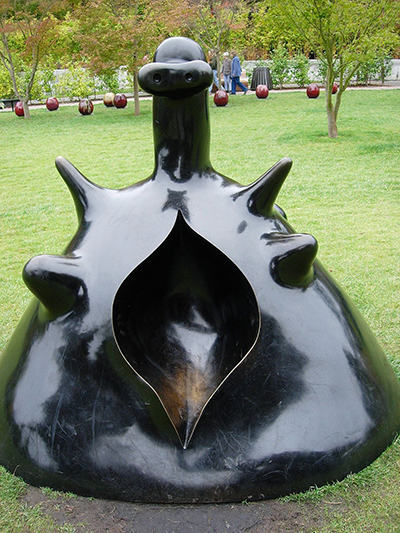Grande Maternite can be found within the Martin H. Bush Outdoor Sculpture Collection at the Wichita State University. It is a large and wide sculpture which is entirely in black.
A single neck-shaped part leads upwards, with other small spikes appearing elsewhere on this otherwise lightly rounded surface. It immediately feels like a natural item, such as perhaps a mythological creature which bears some resemblance to a tortoise or something similar. The all-black nature of the sculpture makes it hard to tell much more than that, and perhaps it is even something placed upside down. The title of Grand Maternite, along with the large hole found at one end of the sculpture perhaps helps us to get closer to the meaning, where this could be a creature giving birth with various limbs pointing into the air. Miro would often spend time designing a mould by hand before then overseeing several different moulds of it being made and would carefully watch the results in order to ensure that the final items were exactly as he had intended.
Miro would start his sculptures as relatively small pieces when first entering this medium before then starting to become more ambitious as he grew in confidence. Two of the most famous examples that he produced were Dona i Ocell and Miro's Chicago, both of which were many metres tall. By the end of his career Miro had achieved a true acceptance by the international art community and he could enjoy commissions in both the US as well as his native Europe. Miro wanted to extend his legacy beyond two dimensional art and also liked the nature of large installations which could better connect with the public, rather than just those who were willing to enter art galleries. His reputation spread much wider as a result of these large outdoor installations and many of these are still on display in the same locations today.
Miro loved alternative worlds and also created iconic symbols which could be spread across many different mediums. Birds, women and eyes would feature many times over and within many artworks he would use a strong sense of colour to help communicate meaning for the highly abstract elements. Sculptures such as this one, though, were entirely in bronze, with no variation in colour and that would create a very different effect. The sculpture here appears real, like something organic from another world with a seamless delivery. It can be hard for those unfamiliar with Miro's work to gain meaning from sculptures such as this, but those who have seen other artworks from his career can normally understand enough to make sense of each part and the probably overall theme.




